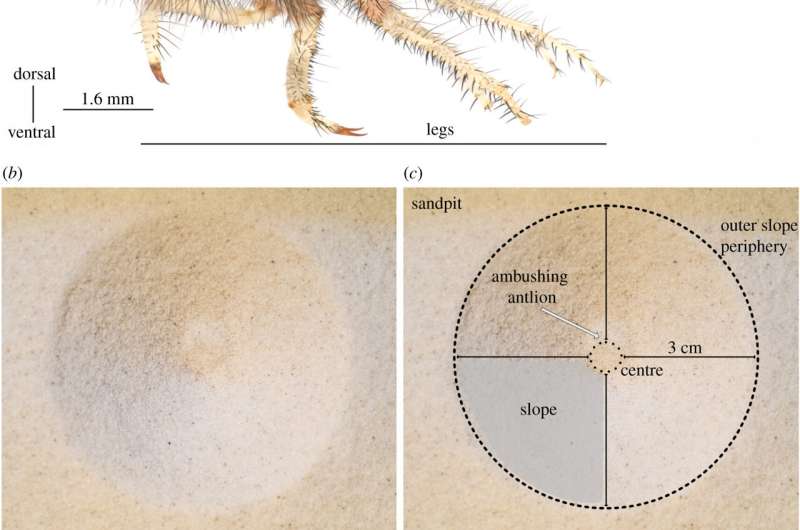September 22, 2021 report
Antlions use sand-throwing to help capture prey

A team of researchers from Kiel and Aarhus universities has found that there is more to the sand-throwing done by antlions than previously thought. In their paper published in Journal of the Royal Society Interface, the group describes their study of netwing larvae and what they learned about its behavior.
Netwings are a group of flying insects that resemble dragonflies, and are sometimes called night dragonflies. In this new effort, the researchers looked at the larval stage of one species of the insects, which are known for digging holes in the ground (in the shape of a funnel) to capture prey. Such traps have been found to average three centimeters deep and eight centimeters in diameter. Once the hole is dug, a larva, called an antlion, hides itself at the bottom, waiting for an ant or other bug to fall into its trap. Prior research has shown that the trap works because the walls are made of sand and collapse when the prey tries to climb out. Prior research has also shown that the antlion is able to flick sand onto the walls of its trap, likely as a means of trap maintenance, as the sand-tossing results in small sandslides. The researchers with this new effort suspected that there was more to the sand-tossing so they collected multiple antlion samples and brought them into the lab for testing.
Back in the lab, the researchers put the antlions into tanks for up-close viewing as they built their funnel traps. The researchers then tossed in different types of prey and watched how both prey and predator behaved.
The researchers found that as ants or other prey stepped over the edge of the trap, they fell in and were unable to climb out. But they also found that once they became trapped, the antlion began throwing sand at them, making it even more difficult for them to climb out. They noted that in addition to irritating the prey, the sand tossing made the walls collapse beneath the prey, ensuring it fell all the way to the bottom of the funnel. They also found that the antlions were careful to use only very fine grains of sand on the walls of the funnel to prevent giving prey toeholds for escape.
The researchers conclude that sand-throwing by the antlion serves two purposes—to instigate sandslides, bringing prey down to the center of the funnel; and to maintain the efficiency of the trap.
More information: Sebastian Büsse et al, Sand-throwing behaviour in pit-building antlion larvae: insights from finite-element modelling, Journal of The Royal Society Interface (2021). DOI: 10.1098/rsif.2021.0539
Journal information: Journal of the Royal Society Interface
© 2021 Science X Network





















